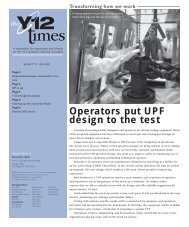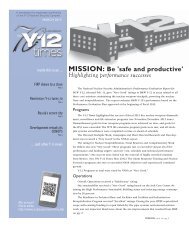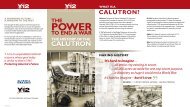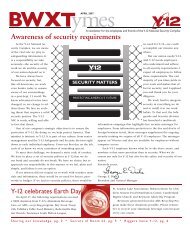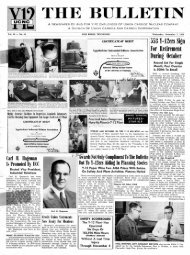A Biography of Dr. John M. Googin - Y-12 National Security ...
A Biography of Dr. John M. Googin - Y-12 National Security ...
A Biography of Dr. John M. Googin - Y-12 National Security ...
You also want an ePaper? Increase the reach of your titles
YUMPU automatically turns print PDFs into web optimized ePapers that Google loves.
FYI<br />
as was desired. This precipitate acts as an ion exchange<br />
medium for both anions and cations and<br />
carried more <strong>of</strong> the ich would feed the chlorination<br />
step. The concentrated nitric acid and ammonium<br />
hydroxide used came in by the tank-car load.<br />
This need for further purification was handled by<br />
the use <strong>of</strong> the peroxide precipitation from nitric acid<br />
solution with piped-in hydrogen peroxide and ammonium<br />
hydroxide. The ammonium precipitation step<br />
served to raise the possible concentration <strong>of</strong> uranium<br />
to high values and this served to compensate<br />
for some <strong>of</strong> the problems with a quantitative precipitation<br />
<strong>of</strong> the peroxide. As originally done, the uranium<br />
peroxide was impossible to filter, and the<br />
recovery was done with a horizontal centrifuge with<br />
a washing beach, the wet cake being discharged into<br />
a dryer-calciner system to make the uranium trioxide<br />
powder for chlorination. The acid centrifugate was<br />
polished in wine-style filters and discharged to the<br />
creek with the copper and nickel that remained, and<br />
lots more ammonium nitrate. Hydrogen peroxide at<br />
30% was received by the tank-car load like the other<br />
chemicals. There were some corrosion problems<br />
where the aluminum pipe <strong>of</strong> the peroxide storage<br />
tanks joined the stainless steel <strong>of</strong> the piping, that had<br />
to be solved with electrically insulating joints.<br />
All <strong>of</strong> these steps were done in what is now the<br />
foundry in Building 9202, and the author worked in<br />
an impromptu laboratory on a storage balcony that<br />
overlooked the operating floor from the top <strong>of</strong> the<br />
highest reactor floor. All the heat <strong>of</strong> the summer and<br />
the process rose up to there. There was the row <strong>of</strong><br />
half a dozen <strong>of</strong> the high-speed centrifuges just below<br />
the lab floor that roared day and night. The dryercalciner<br />
system kept hot air rising toward the ro<strong>of</strong>.<br />
FYI 40<br />
Yellow uranium oxide dust settled over everything,<br />
because the very fine oxide powder made from the<br />
peroxide was hard to hold in the calciner. This<br />
author’s desk received 50 mg <strong>of</strong> uranium oxide per<br />
square decimeter per day. The uranium throughput<br />
was hundreds <strong>of</strong> pounds per day and the need was<br />
soon to be for thousands.<br />
Parts <strong>of</strong> the plant made <strong>of</strong> 304 stainless steel<br />
were corroding away at the welds. One <strong>of</strong> the first<br />
jobs was to set up corrosion tests <strong>of</strong> samples <strong>of</strong><br />
welded stainless steels, to find out which <strong>of</strong> the<br />
commercially available ones would be best for replacement<br />
<strong>of</strong> the one originally used, and for the new<br />
facilities. It soon became apparent that the carbide<br />
precipitates in the heat affected zone <strong>of</strong> the welds<br />
was a large part <strong>of</strong> the problem, and that the low<br />
carbon version <strong>of</strong> 316 was the obvious choice above<br />
321 and 347 for the future stainless steel applications.<br />
All <strong>of</strong> the chemical operators in the bulk treatment<br />
department were women. They were all local<br />
people from East Tennessee and adjacent states. The<br />
ladies selected to handle the heavy centrifuge bowls<br />
on a routine basis were big and strong. All <strong>of</strong> the<br />
forepeople were men. Some <strong>of</strong> the better-educated<br />
women were tried as forepeople. In every case this<br />
created conflict in the ranks <strong>of</strong> the other women. It<br />
was found that the ladies would work together<br />
under a man and even try to make him look good, if<br />
he was not too able—but nice. Under the press <strong>of</strong><br />
wartime, little time could be taken to improve the<br />
situation. A number <strong>of</strong> better educated women were<br />
made into laboratory technicians and some were<br />
assigned to work with this author from time to time.



